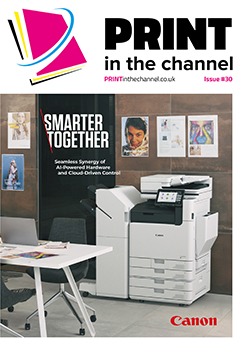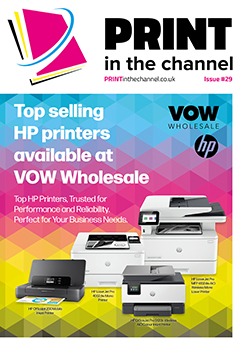While adoption of cloud print is growing among SMBs, there are still some that are resistant to it and for a variety of reasons. But these perceived barriers can be overcome by resellers. Cloud print management solutions have been growing in popularity among small- to medium-sized businesses (SMBs) in recent years. Indeed, Quocirca’s Cloud Print Services 2024 report found that 67% of SMBs (which it classes as businesses with 250-499 employees) already use a cloud print management solution.
Meanwhile 27% of businesses don’t have a solution in place but are planning to and 6% have no plans.
It seems there are still barriers that SMBs face to adopting cloud print management solutions. Louella Fernandes, CEO of Quocirca, notes that Quocirca’s research shows that the biggest barrier to cloud print adoption among SMBs is cost, followed by concerns about protecting company data.
“In addition, 27% of SMBs are concerned about the perceived risk of vendor lock-in, compared to 13% of larger enterprises,” she says. “These barriers differ considerably from the perceived barriers among larger organisations, which revolve more around functionality and management. Resellers serving this market should be prepared to address these specific SMB concerns.”
Stuart Brookes, EMEA head of sales & channel at PaperCut, adds that awareness is probably the first barrier for SMBs, particularly those at the smaller end. “Many SMBs may not be aware what cloud print is, why they need it, its benefits and how they go about implementing it,” he says. “Other concerns relate to how disruptive cloud migration will be, given that downtime typically impacts SMEs more acutely than larger organisations.”
Graham Foxwell, product marketing lead at Kyocera Document Solutions UK, adds that cost is another common barrier. “The initial investment and ongoing costs associated with cloud services can be overwhelming for SMBs,” he says. “Kyocera provides flexible pricing models and scalable solutions tailored to fit the budget of SMBs.
“The lack of skilled resources is also a challenge; SMBs may struggle to find IT professionals with the necessary skills to manage cloud services. Kyocera offers comprehensive support and managed services, allowing SMBs to focus on their core business activities.
“Maintenance and reliability issues arise from the perception that cloud services require constant support; Kyocera Cloud Print and Scan (KCPS) ensures high reliability and minimal downtime through proactive monitoring and regular maintenance. Finally, navigating compliance and regulations can be complex; KCPS helps SMBs meet security standards and offers compliance support. Addressing these concerns through education, robust security measures, and clear cost-benefit analyses can help SMBs feel more confident in adopting cloud print solutions.”
Denis Slavin, national business development sales director, partner channel, Ricoh, says that as well as security and cost concerns, there are worries about functionality. “Cloud print solutions might not offer the same level of functionality and customisation as traditional on-premises systems,” he says.
“Concerns about reliance on a stable internet connection and potential network issues can impact the perceived reliability of cloud print solutions too.”
How resellers can help
Resellers have an important role to play in helping SMBs to overcome these perceived barriers to adopting cloud print management solutions.
One key aspect is educating customers. “Education is a must – especially around the data protection performance of cloud print solutions,” says Louella. “Specialist providers will always have more resources to devote to security than in-house teams and this should be emphasised to customers.
“But broader education is also needed as cloud printing is a nebulous term – meaning cloud printing (i.e. sending print jobs to print via cloud) as well as full cloud print management using a third-party provider and also serverless printing.
“It’s important that customers understand what they want, what is available, and whether they have a compelling need for cloud print if they are operating smaller print fleets. Resellers can help them gain this understanding and recommend solutions to appropriately.”
Stuart agrees that resellers play a key role in educating customers. “This should be via regular communication that points to the benefits that cloud print brings to SME customers,” he says. “For instance, not many SMEs have an in-house tech support expert, so it’s important for resellers to outline how cloud-based print takes away many tech pain points and delivers peace of mind; from simplified software updates to keep print productive and secure to improved ease of use, the flexibility to accommodate BYOD, reduced print costs and improved sustainability.
“Cloud print can also unlock more options for SMEs with respect to the pricing model – subscription or perpetual – best suited to their current and future print needs. This pricing flexibility can have a considerable bearing on one thing crucial to SMEs’ survival; cash flow and forecasts.”
Denis adds that resellers can provide expertise and knowledge of cloud print solutions. “By educating customers about what cloud print offers, understanding the customer’s must-haves and like-to-haves, and offering expertise in cloud print solutions, resellers can help build trust with customers and aid them in moving to the cloud,” he says.
Graham agrees that education and training is important. “Such as offering comprehensive training programs and resources to effectively educate SMBs about the benefits and security measures of cloud print,” he says. “This includes webinars, detailed documentation, and hands-on workshops.”
Managed services are another way, he adds. “Kyocera supports resellers in offering managed services by providing a robust backend infrastructure and dedicated support teams, ensuring ongoing support and maintenance to SMBs.
“Security assurance is vital as well; Kyocera equips resellers with detailed information about the security features of KCPS, including case studies and compliance certifications, which helps reassure SMBs about the robust security measures in place. By partnering with Kyocera, resellers can leverage these resources and support to help SMBs overcome barriers and successfully adopt cloud print solutions.”
Importance of security
One of the most important considerations for customers – and therefore resellers – is security for cloud print management solutions.
Terry Caulfield, chief commercial officer at Brother UK, notes that about 32% of businesses cite data protection concerns as their top barrier to adopting cloud print solutions. “Resellers have a key role in addressing these concerns, playing the role of trusted advisor in facilitating the transition to cloud print, while offering support and training during implementation and helping to maintain systems,” he says.
“We’re working with partners like Tungsten Automation to offer Brother Cloud Solutions (BCS). It’s a portfolio of tools we provide to our reseller partners to help customers with their document digitisation processes, and to transform print infrastructure, without compromising on security.
“Businesses will be turning to cloud solutions for a multitude of reasons from improving workflow efficiencies, and overhauling their print infrastructure, to making cost savings. Resellers can combine any of our BCS tools to address the unique requirements and challenges of a business. For example, location-aware technology, for area managers regularly visiting multiple offices or GPs operating out of different surgeries, who need to print securely from anywhere.”
Stuart notes that all businesses hold confidential information specific to them and many more will also hold confidential customer or market data as well as their own IP. “Therefore, it’s important that the print
eco-system has security pinned down to prevent data leaks before, during and after a print incident,” he says. “Everyone – including end users – is responsible for print security, and we must always remember that where print is concerned, ‘nothing is safe until everything is safe.’”
Ian Fox, UK channel solutions and services specialist at Xerox, agrees that security is high on the list of concerns. “However, even the most change-averse SMBs are exposed to cloud solutions for their key business function such as banking, accounting and payroll,” he says. “Why shouldn’t it be the same with print? The reality is that a well-managed SaaS cloud print management solution, such as Xerox Workplace Cloud, can be much more secure than many of the ageing on-premises and badly patched file and print servers that SMBs are so reliant on.”
Graham says that customers need assurance that their data is protected at all stages, from document creation to final print. “Regular security updates are provided to address emerging threats, maintaining a high level of security. KCPS allows businesses to customise security settings according to their specific needs,” he says.
Ensuring security is critical to protect the company’s assets and intellectual property, Denis adds. “It also safeguards the solution from potential threats compromising its functionality and reliability,” he says. “A secure solution would ensure smooth operations and avoid possible losses due to security breaches.”
Bespoke solutions
Resellers should also look to make cloud print solutions bespoke to each business. “There will be some core commonality between different businesses’ print functions, but beyond that cloud print architecture will be unique to each customer; an SME selling clothes online will have a different set of cloud-based print requirements to, say, a legal firm,” notes Stuart.
Ian agrees that there will be many common requirements from a cloud print solution. “Such as secure print, device authentication, improved scanning workflows and reporting,” he says. “However, this mustn’t be at the expense of productivity. For example, configuring bypass queues for transactional-related print streams so that these are still audited but not necessarily held ensures that productivity is not negatively impacted.”
Graham agrees that cloud print solutions should be tailored to meet the specific needs of each business. “KCPS offers flexible and scalable solutions that can be customised to fit various business requirements,” he says. “Customisable features include options for print policies, user access controls, and workflow automation. KCPS is designed to scale with your business; whether you’re a small business with a few employees or a growing enterprise, Kyocera’s solutions can expand to meet your increasing demands without compromising performance or security.
“Kyocera understands that different industries have unique requirements and can therefore offer industry-specific solutions that cater to the distinct needs of sectors such as healthcare, education, legal and finance. Ongoing support and consultation are also provided to help businesses adapt and optimise their cloud print solutions over time.”
Denis notes that the advantage of moving to the cloud is generally the lower cost of using a multi-tenanted solution hosted by the cloud service provider. “Cloud-based solutions allow specific settings to be configured per tenant; however, they are generally non-bespoke,” he says. “Implementing standardised solutions has lower costs in applying and supporting them.”
Future
Demand for cloud print solutions is expected to continue to rise among SMBs in the coming years. “Hybrid cloud deployments will continue to dominate business infrastructure due to security concerns,” says Louella. “Microsoft’s investment in Universal Print is likely to have an impact at enterprise level and this may involve a trickle-down effect prompting more SMBs to look at cloud printing solutions.”
Stuart adds that the emergence of more cloud first companies will help to drive adoption. “What will be interesting to observe are dynamics like the ratios they adopt public cloud, private cloud or hybrid cloud, as well as whether we’ll see increases in cloud scanning over scan to email,” he says.
Ian adds that he anticipates that as SMBs try to do more with less, they seek ways to simplify their systems, allow staff to focus on core operations, and increase productivity. “Moving away from on-premises infrastructure makes their systems more agile and easily scalable, providing better support for modern hybrid working environments,” he says.
Graham says that factors such as the increasing adoption of remote and hybrid working, the need for flexible and scalable printing solutions and the overall shift towards cloud-based services will continue to drive the trend for cloud print managment.
Denis agrees. “The demand for cloud print solutions will be driven by customers adopting a cloud-first approach for new software, increasing remote work and hybrid workplaces and the cost savings realised by moving to the cloud,” he says.
Customers will also continue to look to resellers for guidance regarding cloud print. “As a vendor we’re committed to offering the necessary training and resources to help,” Terry says. “We also understand that there are businesses not ready to fully transition to the cloud who will want to take a hybrid approach.”










